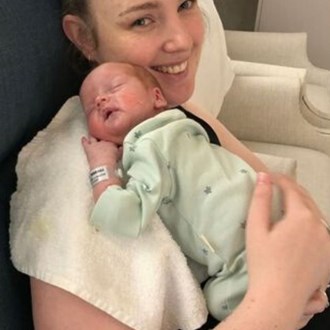Baby sleep school: What it's really like

After five months of her baby not sleeping, Michelle was beyond exhausted. Would five days at sleep school be the answer?
By Michelle - practicalparenting
June 01 2016
Right from the start, whatever my husband and I did, we just couldn’t get our daughter, Indi, down to sleep in the evening. We held and bounced her on the fit ball, patted, rocked and carried her in the sling, drove her around the block, pushed the pram, fed her near-continuously. I sprayed her mattress with lavender, eliminated dairy, yeast and countless other foods from my diet, googled, read and watched DVDs. I sought help from three lactation consultants, a hotline whose number I knew by heart, even a paediatric gastroenterologist, but was mostly told to just hang in there, that it was just a stage and it would pass.
While I waited for things to improve, I ran into a few mums who suggested going to sleep school. When Indi was around 10 weeks old I took their advice and filled out the forms for a program at a local private hospital. Looking at my forms, the staff suggested I take part in the five-night residential stay. The good news was it would all be covered by my private health insurance (the cost was around $1,000 a day, but I only paid the $200 excess for the stay). The bad news? I’d have to wait nine long weeks for a spot.
As those weeks dragged on, Indi’s sleep became more erratic. Her day naps, from which she’d wake screaming, lasted only 45 minutes, and she was still difficult to put down at night, waking every one to three hours. I was craving some sort of structure to our lives and really needed help. Exhausted, excited, but also a bit sceptical, you better believe I was counting the days until sleep school.
Getting started at sleep school
At last, with Indi now five months old, we started the program. For the first two days the staff settled all the babies while the four other mums and I got to catch up on some much-needed rest. Although it was hard to hear Indi grizzle and cry from behind closed doors, I knew I had to allow the staff to do their jobs and be guided by them in order to get results.
During these first two days I was introduced to flexible feed, play and sleep routines to see Indi through her first year. At five months old, the key points were that she had to be up by 8am, then awake for one-and-a-half to two hours and then down for a sleep. The first two sleeps of the day were to be two hours long, with a further catnap in the afternoon from which she should be up by 5.30-6pm to allow for a 7-7.30pm bedtime.
The staff also introduced a ‘rollover’ feed between 10.30-11.30pm, done with minimal disruption to bub.
I was told that if Indi woke up for this it was fine, but if she was to stay asleep this was also fine. Lights were to be kept low and distractions minimal. As Indi had doubled her birth weight, the staff said that she wouldn’t need an extra night feed after the rollover to get her through to the morning. If she was to wake at any time, she was to be settled while in her cot.
On the second day, a session on settling was held for mums, partners and other carers. I had previously rushed in the moment Indi started to cry, without allowing her time to self-settle, but we were taught to allow for 10 minutes of grizzling (20 minutes during the night) or two minutes of all-out crying before going in. The settling method we were shown consisted of a fast double pat, slowed to a single pat on bub’s side whilst she was turned on her side, facing away, along with some ‘shushing’.
The distinction between grizzling and crying was important to figure out. I would describe crying as a consistent, sustained and loud sound that doesn’t taper off but rather stays the same or becomes more amplified and distressed-sounding. Grizzling can include a cry, but is usually punctuated with silences and different sounds. The sounds aren’t consistent, and the volume will also increase and decrease.
Doing it myself
By day three, all the settling was left to me. Remarkably, the staff had already done the hard yards – Indi was starting to self-settle and her first two day sleeps were around two hours long. I was astonished! By the difficult third ‘catnap’ I had to get my hands busy using the settling technique, but it really did work and Indi went off to sleep, something she only ever used to do (if at all) in the car or the pram. That night, she only needed a couple of settles to get her off to sleep and I had to wake her for the rollover feed. She grizzled throughout the night, eventually self-settling but, amazingly, she slept in until 8am, obviously catching up on her lack of sleep from the previous months! I was starting to feel elated.
Days four and five continued in a similar fashion with Indi’s self-settling improving. She was looking less tired and, as for me, after some forced rest and relaxation, further group sessions and a massage (all part of the program), I was starting to feel like myself again. I felt more positive and more in control. This sentiment was shared by the other mums, and by our fifth and final night our sleep school experience had been so affirming we celebrated with some champagne and had to be told to get to bed, just like naughty school girls!
But the first week back at home was tough, as not only were we staying at home for all sleeps (as encouraged by staff, so Indi could maintain her routine), but Indi was resisting sleep like she’d never been to sleep school. Thankfully, the incredible staff were available for follow-up calls and they encouraged me to stick with what we’d learnt.
For about three weeks, we did a lot of shushing and patting, but then everything just fell into place. Sure, Indi still wakes occasionally for her rollover feed, sometimes grizzles during her sleep and needs to be settled every now and then, but sleep school not only helped my baby to sleep so much better, it also restored my confidence as a parent.






